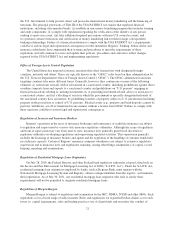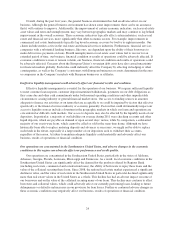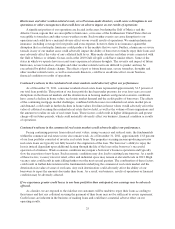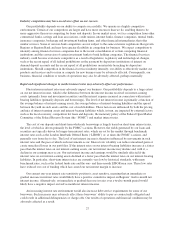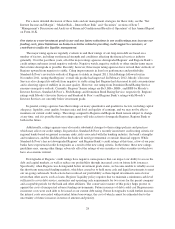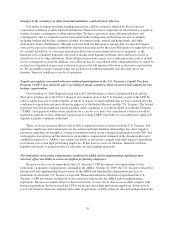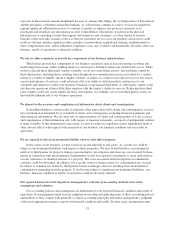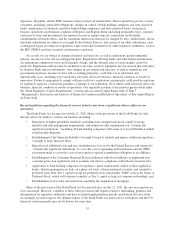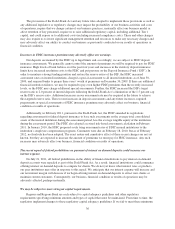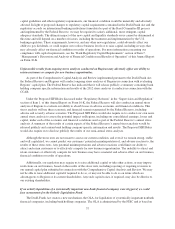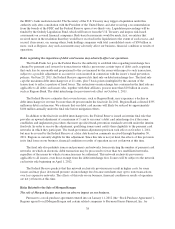Regions Bank 2011 Annual Report Download - page 52
Download and view the complete annual report
Please find page 52 of the 2011 Regions Bank annual report below. You can navigate through the pages in the report by either clicking on the pages listed below, or by using the keyword search tool below to find specific information within the annual report.For a more detailed discussion of these risks and our management strategies for these risks, see the “Net
Interest Income and Margin”, “Market Risk – Interest Rate Risk” and “Securities” sections of Item 7.
“Management’s Discussion and Analysis of Financial Condition and Results of Operation” of this Annual Report
on Form 10-K.
Our status as a non-investment grade issuer and any future reductions in our credit ratings may increase our
funding costs, place limitations on business activities related to providing credit support to customers, or
contribute to ineffective liquidity management.
The major rating agencies regularly evaluate us and their ratings of our long-term debt are based on a
number of factors, including our financial strength and conditions affecting the financial services industry
generally. Over the past three years, all of the major ratings agencies downgraded Regions’ and Regions Bank’s
credit ratings and many issued negative outlooks. Negative watch, negative outlook or other similar terms mean
that a future downgrade is possible. Recently, however, three major rating agencies have revised their outlooks of
Regions upward from negative to stable. Citing improvements in loan loss performance and profitability,
Standard & Poor’s revised its outlook of Regions to stable in August 2011. Fitch Ratings followed suit in
November 2011, noting that Regions’ overall risk profile had improved. In February 2012, Moody’s Investor
Services also changed its outlook from negative to stable citing that Regions had decreased its risk concentrations
and is showing signs of stability in its asset quality. However, our rating from Dominion Bond Rating Service
remains on negative outlook. Currently, Regions’ Senior ratings are Ba3, BB+, BBB-, and BBB by Moody’s
Investor Services, Standard & Poor’s, Fitch Ratings and Dominion Bond Rating Service, respectively. Regions’
ratings with Moody’s Investor Services and Standard & Poor’s and Regions Bank’s ratings with Moody’s
Investor Services are currently below investment grade.
In general, ratings agencies base their ratings on many quantitative and qualitative factors, including capital
adequacy, liquidity, asset quality, business mix and level and quality of earnings, and we may not be able to
maintain our current credit ratings. The ratings assigned to Regions and Regions Bank remain subject to change
at any time, and it is possible that any ratings agency will take action to downgrade Regions, Regions Bank or
both in the future.
Additionally, ratings agencies may also make substantial changes to their ratings policies and practices
which may affect our credit ratings. In particular, Standard & Poor’s recently issued new credit rating criteria for
regional banks based on general economic risks, risks associated with the banking industry, the bank’s strengths
and weaknesses, and the likelihood that the bank will need governmental or outside financial support. While
Standard & Poor’s has not downgraded Regions’ and Regions Bank’s credit ratings at this time, a few of our peer
banks have experienced credit downgrades as a result of the new rating criteria. In the future, these new ratings
guidelines may, among other things, adversely affect the ratings of our securities or other securities in which we
have an economic interest.
Downgrades of Regions’ credit ratings have negative consequences that can impact our ability to access the
debt and capital markets, as well as reduce our profitability through increased costs on future debt issuances.
Specifically, when Regions was downgraded below investment grade status, we became unable to reliably access
the short-term unsecured funding markets, which has caused us to hold more cash and liquid investments to meet
our on-going cash needs. Such actions have reduced our profitability as these liquid investments earn a lower
return than other assets, such as loans. Regions’ liquidity policy requires that we maintain a minimum cash level
sufficient to cover debt service, maturities and operating cash requirements for two years for the parent company
and acceptable periods for the bank and other affiliates. The conservative nature of this policy helps protect us
against the costs of unexpected adverse funding environments. Future issuances of debt could cost Regions more
in interest costs were such debt to be issued at our current debt rating. Future downgrades would further increase
the interest costs associated with potential future borrowings, the cost of which cannot be estimated due to the
uncertainty of future issuances in terms of amount and priority.
28





